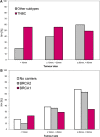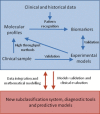Triple-negative breast cancer: present challenges and new perspectives
- PMID: 20537966
- PMCID: PMC5527939
- DOI: 10.1016/j.molonc.2010.04.006
Triple-negative breast cancer: present challenges and new perspectives
Abstract
Triple-negative breast cancers (TNBC), characterized by absence of estrogen receptor (ER), progesterone receptor (PR) and lack of overexpression of human epidermal growth factor receptor 2 (HER2), are typically associated with poor prognosis, due to aggressive tumor phenotype(s), only partial response to chemotherapy and present lack of clinically established targeted therapies. Advances in the design of individualized strategies for treatment of TNBC patients require further elucidation, by combined 'omics' approaches, of the molecular mechanisms underlying TNBC phenotypic heterogeneity, and the still poorly understood association of TNBC with BRCA1 mutations. An overview is here presented on TNBC profiling in terms of expression signatures, within the functional genomic breast tumor classification, and ongoing efforts toward identification of new therapy targets and bioimaging markers. Due to the complexity of aberrant molecular patterns involved in expression, pathological progression and biological/clinical heterogeneity, the search for novel TNBC biomarkers and therapy targets requires collection of multi-dimensional data sets, use of robust multivariate data analysis techniques and development of innovative systems biology approaches.
(c) 2010 Federation of European Biochemical Societies. Published by Elsevier B.V. All rights reserved.
Figures



References
-
- Acharya, C.R. , Hsu, D.S. , Anders, C.K. , Anguiano, A. , Salter, K.H. , Walters, K.S. , Redman, R.C. , Tuchman, S.A. , Moylan, C.A. , Mukherjee, S. , Barry, W.T. , Dressman, H.K. , Ginsburg, G.S. , Marcom, K.P. , Garman, K.S. , Lyman, G.H. , Nevins, J.R. , Potti, A. , 2008. Gene expression signatures, clinicopathological features, and individualized therapy in breast cancer. JAMA. 299, 1574–1587. - PubMed
-
- Aebersold, R. , Auffray, C. , Baney, E. , Barillot, E. , Brazma, A. , Brett, C. , Brunak, S. , Butte, A. , Califano, A. , Celis, J. , Cufer, T. , Ferrell, J. , Galas, D. , Gallahan, D. , Gatenby, R. , Goldbeter, A. , Hace, N. , Henney, A. , Hood, L. , Iyengar, R. , Jackson, V. , Kallioniemi, O. , Klingmuller, U. , Kolar, P. , Kolch, W. , Kyriakopoulou, C. , Laplace, F. , Lehrach, H. , Marcus, F. , Matrisian, L. , Nolan, G. , Pelkmans, L. , Potti, A. , Sander, C. , Seljak, M. , Singer, D. , Sorger, P. , Stunnenberg, H. , Superti-Furga, G. , Uhlen, M. , Vidal, M. , Weinstein, J. , Wigle, D. , Williams, M. , Wolkenhauer, O. , Zhivotovsky, B. , Zinovyev, A. , Zupan, B. , 2009. Report on EU-USA workshop: how systems biology can advance cancer research (27 October 2008). Mol. Oncol. 3, 9–17. - PMC - PubMed
-
- Agrawal, A. , Gutteridge, E. , Gee, J.M. , Nicholson, R.I. , Robertson, J.F. , 2005. Overview of tyrosine kinase inhibitors in clinical breast cancer. Endocr. Relat. Cancer. 12, (Suppl. 1) S135–S144. - PubMed
-
- Alfieri, R. , Barberis, M. , Chiaradonna, F. , Gaglio, D. , Milanesi, L. , Vanoni, M. , Klipp, E. , Alberghina, L. , 2009. Towards a systems biology approach to mammalian cell cycle: modeling the entrance into S phase of quiescent fibroblasts after serum stimulation. BMC Bioinformatics. 10, (Suppl. 12) S16 - PMC - PubMed
Publication types
MeSH terms
Substances
LinkOut - more resources
Full Text Sources
Other Literature Sources
Medical
Research Materials
Miscellaneous

